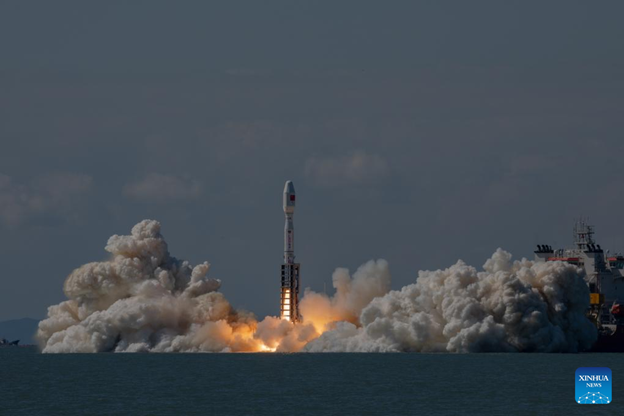Did anyone in Washington notice that China tested a nuclear capable long-range ICBM with a dummy warhead on September 25? It landed in the Pacific Ocean with no “notified” overflight announcement to nearby countries, although in Washington DOD said it had “some” notice from Beijing. Brent Sadler, a senior research fellow at the Heritage Foundation notes that China chose to launch at a time when international tensions are high not only in Europe and the Middle East but also across East Asia. The news gets worse. US lawmakers recently confirmed the CCP now has more ICBM launchers than the United States. This is a fivefold quicker increase than Washington predicted.
Beijing has been preparing for war for a long time. As far back as 1980, a Chinese newspaper published a map of Asia with circles drawn to indicate the countries within the target area of its launch of a DF-5 missile. They included the Solomon Islands, Fiji, Nauru, the Gilbert Islands, Tuvalu, western Samoa, and the New Hebrides. One member of the intelligence community active in the region recently commented, “We should have been seeing the lights flashing red, but we continue to ignore them.” ICBM’s have a range of over 3,500 miles. China’s missiles can strike targets almost anywhere in the world. Beijing’s DF-41, its longest-range missile, can travel an estimated 9,300 miles. San Francisco is 6,100 miles from Shanghai.
Washington must not be misled by suggestions that this week’s ICBM launch is simply a normal event, according to numerous members of the intelligence community. Sadler points out that China frequently tests fractional orbital bombardment missile systems, including a recent launch in July 2021. Beijing’s trajectory is not one of peace. It is not deterred by the West. It is accelerating and expanding its military readiness and technological capabilities to launch a war in the Pacific. Jeffrey Lewis, a missile expert at the James Martin Center for Nonproliferation Studies at the Middlebury Institute of International Studies says “We’re entering a new age… where the United States and China are engulfed in what feels like an arms race… It is a China that does not feel constrained… and [they are] demonstrating to others they work.”
Taiwan’s President, William Lai, continues to warn about China’s ambition for global hegemony after the recent test. A spokesperson for the Australian government stated that “The launch comes in the context of China’s rapid military build-up, which is taking place without the transparency and reassurance that the region looks for from great powers… [It] is destabilizing and raises the risk of miscalculation in the region….” In Japan, the reaction was similar with a government spokesperson at a press conference noting Tokyo had “no advance notice.” This comes after China increased its military presence around Japan during the last month and, in an unprecedented move, breached Japanese air space using one of its military aircraft.
The CCP’s missile message also serves a domestic purpose. The government has endured repeated scandals over corruption within the People’s Liberation Army Rocket Force (PLARF). It purged many of its senior military leaders. Timothy Heath, a senior international defense researcher at RAND Corporation suggested “The test was an opportunity for the PLARF to restore its credibility with China’s leadership” and show that it remained capable despite the corruption scandals. Johnn Ciociari, dean of the Hamilton Lugar School of International Studies at Indiana University pointed out that “Within China, it supports a nationalist narrative about the government’s competence and resolve… Regionally, it is part of a broader effort to discourage China’s neighbors from challenging Beijing on Taiwan or other flashpoints.” He added that “To global audiences, the test may seek to amplify perceptions that China is gaining rapidly on the United States in military power and technological prowess.”
There is yet another urgent concern for Washington beyond China’s perceived intent to show it is ICBM-capable of attacking the United States. Some in the military intelligence community in Washington are concerned that due to the financial cost of Russia’s war in Ukraine, Moscow may be manufacturing and likely selling advanced military technologies that fill any remaining gaps the CCP has in its arsenal. The US must be prepared under the oceans, on the ground, and in space to confront Chinese aggression.
Daria Novak served in the U.S. State Dept.
Photo: A Smart Dragon-3 carrier rocket carrying eight satellites blasts off from the waters near the city of Haiyang in east China’s Shandong Province, Sept. 24, 2024. China launched the rocket on Tuesday, placing eight satellites into planned orbit. The commercial rocket blasted off at 10:31 a.m. (Beijing Time), carrying Tianyi-41 and other satellites. The Taiyuan Satellite Launch Center carried out this offshore launch. (Photo by Guo Houze/Xinhua)
